
Most of you have realized by now that in a cage match between yourself and Mother Nature you have very low odds of winning. The second you turn your head, she’s got the upper hand.
For example, have you ever noticed the transformation of one of your beloved variegated plants from a multi-colored beauty into an ordinary solid green shrub?
If you haven’t been paying attention for awhile, you might think you’re going crazy, certain you had planted a focal point plant in its place a few years back.
What happened?
This reversion happens more often than not, and is due to a leaf’s variegation. In a nutshell, a variegated leaf is one without pigmentation, which isn’t so great for the plant since pigment is what absorbs the chlorophyll, supplying the plant with energy.
That’s why you may have noticed that variegated plants aren’t usually as hardy as the solid-green versions. So naturally, the variegated plant will try and send out its sturdier, hardier, and tougher solid green leaves to take the place of the weaker leaves.
If you don’t prune these rogue green leaves and stems back to the base of the plant, soon your entire plant will be an uninspired shade of solid green.
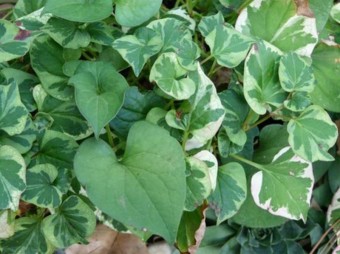
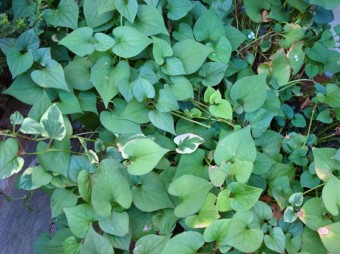
My Houttuynia cordata ‘Chameleon’ is a perfect example. Just a few months ago, it was variegated with just a few solid green leaves (photo on the left). I went on vacation, did a couple of things around the house, and before I knew it – BAM – the whole plant is green with just a few variegated leaves struggling to survive!
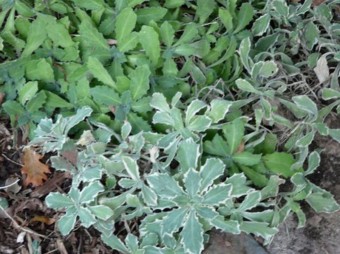
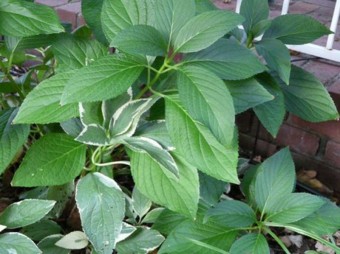
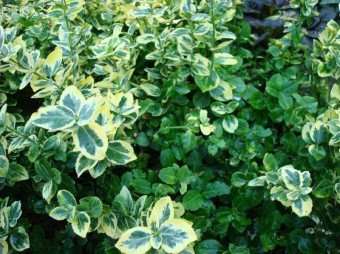

Arabis, Hydrangeas, Euonymus and Pittosporum are just a few examples of other plants which want to revert back to green given enough time.
My hair, on the other hand, is just the opposite – its sending out variegated hairs at the speed of light. Mother Nature can be so unfair.






13 Comments
Ha Ha Ha 🙂 There you go being seriously funny again while at the same time educating us! I didn’t know that cutting off the solid green leaves would help! I just thought I had to live with it…thank you for the good advice and the good giggle!
Thanks Frances & Scott – glad to hear you’re both enjoying your own natural hair variegation….I, however, am fighting it to the bitter end…..(and quickly losing)
Varigated hair?, no problem here( thanks again for the y chromosome, Dad) it just makes us look extinguished…err, distiguished, ya, thats it …distinguished.
Good subject Rebecca, like the blog.
Scott
Hi Rebecca, love the idea of variegated hair! We are going back to the natural and as the red lengths give way to variegated new growth, it is best to avoid the mirror. Now to the plants, the one most troubling here is the Sedum ‘Frosty Morn’. The frost is gone and even the habit has reverted to long and floppy. Dang those chimeras! 🙂
Frances
I always learn cool stuff from your blog posts. Keep ’em coming Rebecca!
Thankfully we can do something about our own variegation! Too funny!
Oh, your explanation was right, I just threw in more detail because I think the whole chimera thing is freakishly cool. I’m a nerd. 🙂
Variegated plants reverted because most of them are what is called “chimeras” — different layers of cells are genetically different, one layer being white, the other layers the usual green. Usually new shoots come from buds, which are made from all the layers of the plant, but sometimes new shoots can originate from a single cell — if that single cell is from the all white layer, you get an albino shoot which quickly dies. If it is from the green layer, you get an all green shoot which quickly takes over.
Thanks for the explanation! you obviously have way more experience in this area than I do…so is my ‘in a nutshell’ theory wrong? (I did check a few places on the web to get some info on this, which doesn’t always mean much as we all know….)? Or does your detailed comment just delve further into the explanation?
Interesting post! You have a great blog design. I can relate to the hair variation. 🙂
Thanks, Amy! Glad you like it!
I hear you on that one.
Good luck pulling out that green Houttynia — that stuff stinks! I remember it from when I worked in a nursery years ago. Like soap, but more acrid. A weird smell.
I agree, Andy – that is one stinky plant! Every time I brush by it, the odor it releases is overpowering. I think I’ll just start over with another variegated one instead of pulling the green shoots out – totally worth the $9.00!